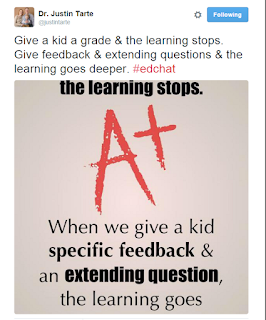I’ve had the pleasure of being an elementary school principal for the past seven years and I have come to realize the missing piece of school improvement is prioritizing our teacher and administrator evaluation. In order for schools to close gaps in achievement and continually grow, schools must prioritize the teacher and administrator evaluation process—changing it from an act of compliance to the key tool in a school’s improvement efforts. Hundreds of hours are spent completing the evaluation process, yet very few of those hours lead to improved outcomes for students. More importantly few of those hours actually lead to changes in teaching practices to better support all learners.
Two years ago I experimented with our evaluation process by encouraging more staff to take on collaborative learning opportunities. Co-teaching, collaborative planning, coaching, and self-directed learning (via Twitter) were some of the methods used and then began to credit these learning opportunities as informal observations. These opportunities turned the evaluation process into what Fisher and Frey (2015) consider essential for learning to be meaningful, relevant learning. I began to notice teaching improved when the evaluation became meaningful to those who were participating. This was a big shift for me and a bigger shift for the teachers in our building. It takes a lot of professional trust with so much emphasis in schools on testing and accountability. The trust must include a shared sense of ownership that we as adults in a school will collectively do whatever it takes to help all students learn at high levels. Jim Knight sums this up in Unmistakable Impact when he says, “When we have faith in others, we let go of the notion that we need to control them, tell them what to do, or hold them accountable.” (Knight, p 40., 2011). Letting go of the evaluation process allows learners (both teachers and administrators) to take risk, make mistakes, and learn from those mistakes to accelerate growth. The idea of sharing mistakes as a means of growth and development is nicely demonstrated by the CEO of Etsy and can be found here.
Of all the informal observations I’ve participated in, the ones which have been most valuable have included adults who took risks, learned from each other, and continually evaluated their teaching’s impact on students. Seeing staff (myself included) struggle to learn and understand new ways of doing things models the growth mindset we all hope to see in our students. In order for us to see more of this, schools need to recognize this learning and embed this as part of a school’s improvement process and evaluation model.
During the 2014-15 school year, our entire school focused our professional learning on delivering quality mini-lessons. We took baseline data on our ability to teach mini-lessons, accepted the fact that some staff did a better job at delivering these mini-lessons than others, and worked together to build the school’s capacity to deliver these lessons. We celebrated our monthly growth and knew exactly what steps we still needed to meet all of the criteria of a quality mini-lesson. This process instilled professionalism within our building in that every adult—whether it be classroom teacher, special education teacher, speech and language clinician or building principal—was expected to learn to deliver an exemplary mini lesson and we dedicated time to learn how to do this together.
As we quickly approach the mid-year point of our school year and I look at ‘how many more’ evaluations I still have to do, I must remind myself this process must continue to grow every adult in our building, as the adults who teach our students are the key factor in our school’s improvement. I have to continually evaluate how I craft our evaluation and feedback to ensure the process is meaningful to our staff. Along with that, I have to be open to feedback from teachers if the time we are investing is not valuable to those who are participating in the process.
Just before the holiday, I had the opportunity to shift roles and be the one evaluated as I delivered guided reading instruction for our kindergarten students. As principal, this is not something that I do on a daily basis and realize I have a lot to learn to improve my practice. As I sat at the kidney table, I was the one who was getting immediate feedback, I was the one who was learning new instructional strategies, and I was the one feeling overwhelmed with all that a teacher is expected to do each day. That being said, this process wasn’t intimidating me because I wasn't worried about ‘the final grade’ of my evaluation.
That sense of not worrying about ‘not being great at something right now' is a climate that I need to continue to grow. By doing so, we can turn the evaluation process into a learning process which will impact how our students’ learn. As I meet with staff for post observations, mid-year meetings, and end-of-year evaluations I have to continually remind myself that a strong evaluation process is a process of learning. If the time dedicated to the evaluation process just focuses on a ‘final grade or score’ we’ve missed the boat.
So my goal for 2016 is to continue to improve upon my efforts to make the teacher and administrator evaluation process our most important form of school and district improvement. This will require upfront and honest conversation about what we do and what we are learning as well the sharing of many successes and many more mistakes as we all learn how to improve upon what we do each day to ultimately support our students.
What are your thoughts? How can we make better use of the evaluation process? Continue the conversation by reaching me @davidjhuber on Twitter. Happy New Year!





